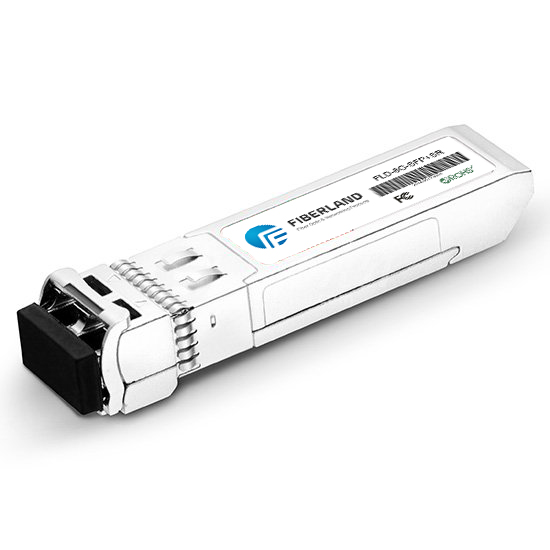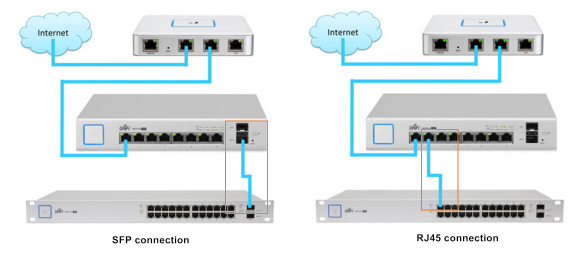RJ45 port VS SFP port of switch, which is better?
2017-08-27
In the optical communications industry should know, Gigabit Ethernet has become increasingly common, and now Gigabit Ethernet switches typically have two ports: RJ45 port and SFP port. They can be used for Gigabit Ethernet transmission. So what are their differences? How should they be wired? Today we will share with you.

What is the difference between the RJ45 port and the SFP port?
The RJ45 port of the Gigabit Ethernet switch is a built-in port. You can connect Gigabit Ethernet switches with two RJ45 ports just using one Cat5 or Cat6 network cables.
The SFP port of the Gigabit Ethernet switch conforms to the 1000BASE-T (IEEE 802.3ab) standard, transmission rate can reach 1000 Mbps. To transmit data, switch SFP port must be inserted into the SFP RJ45 module, and then use the cable; Or insert two SFP module, and then use one patch cord.
In addition, in the data center, local area network (LAN) and other applications, the SFP port of the switch also with 100/1000Mbps adaptive function.
RJ45 connections and SFP connections of Gigabit Ethernet switches
The following picture shows the RJ45 connection and SFP connection instances of the Gigabit Ethernet switches. SFP connection need to use two SFP RJ45 module and one Cat5 cable, or use two SFP port module and one patch cord; while RJ45 connection just needs to use one Cat5 cable.

From above we can know, RJ45 port and SFP port performance is basically the same, but the SFP port wiring cost is higher. Nevertheless, SFP port is better than RJ45 port, because it can support the SFP RJ45 module and SFP port module. The transmission distance is also longer than RJ45 port when using SFP port optical transceiver, it has high flexibility in practical applications, and scalability is also high.
Hope this blog will give you a better understanding of the differences between RJ45 ports and SFP ports in switches!
XFP module,XFP transceiver,bidi sfp,SFP+ module,SFP+ transceiver Which is good? First choice Fiberland!Thanks for your concern, to learn more about Fiberland, please enter Fiberland website: http://www.fiberlandtec.com/

What is the difference between the RJ45 port and the SFP port?
The RJ45 port of the Gigabit Ethernet switch is a built-in port. You can connect Gigabit Ethernet switches with two RJ45 ports just using one Cat5 or Cat6 network cables.
The SFP port of the Gigabit Ethernet switch conforms to the 1000BASE-T (IEEE 802.3ab) standard, transmission rate can reach 1000 Mbps. To transmit data, switch SFP port must be inserted into the SFP RJ45 module, and then use the cable; Or insert two SFP module, and then use one patch cord.
In addition, in the data center, local area network (LAN) and other applications, the SFP port of the switch also with 100/1000Mbps adaptive function.
RJ45 connections and SFP connections of Gigabit Ethernet switches
The following picture shows the RJ45 connection and SFP connection instances of the Gigabit Ethernet switches. SFP connection need to use two SFP RJ45 module and one Cat5 cable, or use two SFP port module and one patch cord; while RJ45 connection just needs to use one Cat5 cable.

From above we can know, RJ45 port and SFP port performance is basically the same, but the SFP port wiring cost is higher. Nevertheless, SFP port is better than RJ45 port, because it can support the SFP RJ45 module and SFP port module. The transmission distance is also longer than RJ45 port when using SFP port optical transceiver, it has high flexibility in practical applications, and scalability is also high.
Hope this blog will give you a better understanding of the differences between RJ45 ports and SFP ports in switches!
XFP module,XFP transceiver,bidi sfp,SFP+ module,SFP+ transceiver Which is good? First choice Fiberland!Thanks for your concern, to learn more about Fiberland, please enter Fiberland website: http://www.fiberlandtec.com/
RECENT BLOG POST
-
012019-10With the continuous development of 5G communication technology, 100G modules are gradually becoming popular. We know that there are many kinds of packages for 100G optical modules. From 2000 to now, the optical module package types have been rapidly developed. Its main package types are: GBIC, SFP, XENPAK, SNAP12, X2, XFP, SFP+, QSFP/QSFP+, CFP, CXP. In the fast-developing network era, some 100G optical modules avoid the risk of being eliminated, and upgraded and revised with the wave of the Internet, such as 100G CFP optical modules.
-
012019-101. What is the CWDM SFP? The CWDM optical module is an optical module using CWDM technology to implement the connection between the existing network device and the CWDM multiplexer/demultiplexer. When used with a CWDM multiplexer/demultiplexer, CWDM optical modules can increase network capacity by transmitting multiple data channels with separate optical wavelengths (1270 nm to 1610 nm) on the same single fiber.
-
012019-10AOC is the abbreviation of Active Optical Cables, which is called Active Optical Cables in Chinese. AOC active optical is to encapsulate two optical modules and cable together. Because the medium of transmission in the middle is optical cable, AOC optical module, which contains laser devices, has a higher price for DAC. However, its optical aperture is not exposed, it has high reliability, and its working distance can be customized for a long distance of less than 100 meters.
-
012019-10Dense Wavelength Division Multiplexing (DWDM) technology is capable of transmitting data in an optical fiber using bit wavelength parallel transmission or string line transmission using the wavelength of the laser.It is widely used in different fields of communication networks, including long-distance backbone networks, metropolitan area networks (MANs), residential access networks, and local area networks (LANs).The DWDM optical module is the optical module that uses this technology, so the DWDM optical module has high bandwidth and long-distance transmission characteristics.












